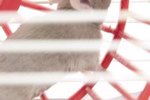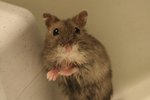
Homemade hamster bedding is an inexpensive alternative to commercial bedding material found in pet stores -- and you’re helping the environment, too. Recycle paper and cardboard products in your home to make bedding for your hamster that is comfortable, clean and absorbent. Hamsters enjoy burrowing and digging into their bedding and preparing their sleeping area. Cover the bottom of your hamster’s habitat with at least two inches of bedding.
Cardboard
Cardboard provides an absorbent, clean bedding material for your hamster. Shipping boxes, greeting cards, toilet paper and paper towel rolls, and egg cartons are acceptable as bedding materials. Discard any cardboard that has ink on the surface because your hamster could ingest the ink when gnawing. Rip cardboard into small pieces and cover the bottom of your hamster’s cage.
Paper
The softest papers for hamster bedding are unscented facial tissues, toilet paper, napkins and paper towels. These work well for absorbing urine. You can also use paper bags and unused computer paper. Brown paper used as packing in shipping boxes is a good choice because it is usually free of ink. You can use a paper shredder instead of ripping the paper by hand.
Paper Pulp
Paper pulp bedding is an absorbent material that helps keep your hamster’s habitat clean and dry. It is time consuming, but the small, compacted balls absorb better than flat pieces of paper. You also can use printed computer paper because the pulping process requires multiple rinsings that remove the ink.
To make pulp, rip computer paper into about 2-inch square pieces and put them in a 5-gallon bucket until it is half-full. Add hot water to the bucket, covering the paper. Do not boil the water because you will be handling the paper in the bucket. Stir the paper around in the water to help remove ink. Squeeze the paper into a large ball and drain it with a strainer. Knead the paper in the strainer until most of the water is gone. Put the paper back into the bucket and cover it again with hot water. Repeat the previous process at least three times to remove ink. Squeeze the paper into baseball-sized balls to help you squeeze out excess water. Soak the balls in hot water for two hours and stir to remove any remaining ink. Drain the paper in a strainer and reform it into balls. Break the paper balls into small pieces, squeezing them into marble-sized pieces, and lay them on a flat surface to air dry. When the paper is completely dry, it's ready for your hamster’s habitat.
Precautions
Although backyard leaves, grass clippings and mulch seem like natural materials for your hamster’s bed, they are potentially hazardous to his health. These materials can contain dust, insecticides, bacteria and insects that could cause health problems for your pet hamster.
References
- Critters USA; Clean Hamster, Happy Hamster; Stacey Leonatti, DVM
- SmallAnimalChannel.com; Hamster Bedding and Litter
- Hamster, Your Happy Healthy Pet; Betsy Sikora Siino
- Chicago Exotics, PC; Hamster Care
Photo Credits
-
Siri Stafford/Digital Vision/Getty Images
Writer Bio
Karen Curley has more than 18 years experience in health and nutrition, specializing in healthy food choices for families. She received USDA certification in food components, nutrient sources, food groups and infant/child nutrition, and holds a B.A. in English from the University of Massachusetts. Curley is also an avid gardener, home renovator, Collie breeder, dog groomer and dog trainer.


